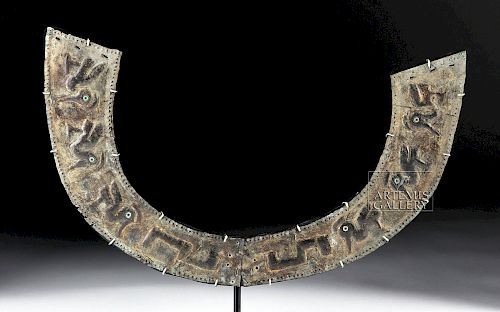Moche Gilded Copper Collar w/ Bird Motifs Shell Eyes
Lot 31b
About Seller
Artemis Fine Arts
686 S Taylor Ave, Ste 106
Louisville, CO 80027
United States
Selling antiquities, ancient and ethnographic art online since 1993, Artemis Gallery specializes in Classical Antiquities (Egyptian, Greek, Roman, Near Eastern), Asian, Pre-Columbian, African / Tribal / Oceanographic art. Our extensive inventory includes pottery, stone, metal, wood, glass and textil...Read more
Estimate:
$2,000 - $3,000
Absentee vs Live bid
Two ways to bid:
- Leave a max absentee bid and the platform will bid on your behalf up to your maximum bid during the live auction.
- Bid live during the auction and your bids will be submitted real-time to the auctioneer.
Bid Increments
| Price | Bid Increment |
|---|---|
| $0 | $25 |
| $300 | $50 |
| $1,000 | $100 |
| $2,000 | $250 |
| $5,000 | $500 |
| $10,000 | $1,000 |
| $20,000 | $2,500 |
| $50,000 | $5,000 |
| $100,000 | $10,000 |
| $200,000 | $20,000 |
About Auction
By Artemis Fine Arts
May 10, 2018
Set Reminder
2018-05-10 10:00:00
2018-05-10 10:00:00
America/New_York
Bidsquare
Bidsquare : Fine Ethnographic / Asian / Ancient Art
https://www.bidsquare.com/auctions/artemis-gallery/fine-ethnographic-asian-ancient-art-3213
Featuring antiquities from around the world including Pre-Columbian, Tribal, Classical, Asian, so much more! Artemis Fine Arts info@artemisfinearts.com
Featuring antiquities from around the world including Pre-Columbian, Tribal, Classical, Asian, so much more! Artemis Fine Arts info@artemisfinearts.com
- Lot Description
Pre-Columbian, Peru, Moche, ca. 100 to 300 CE. An incredible copper collar made from two curved segments with two thin copper straps holding them together at their center. Eight repousse motifs decorate the collar, four on each half: three birds with long, pelican-like beaks, and large, curving crests, and a step-like motif near the center. The edges of the collar have tiny repousse dots forming a border. Three long rectangular holes at each end and eight small holes at the center would have allowed attachment of this beautiful item to a tunic or some other piece of clothing. The birds are in profile, and each has a round disc made of shell forming its eye. The copper has been gilded, with some of the gilding remaining in the lower profile areas. Size: 14" W x 8.75" H (35.6 cm x 22.2 cm); 11" H (27.9 cm) on included custom stand.
Andean societies thought of birds as precious resources; there was a roaring trade, for example, in parrot and macaw feathers from the Amazon Basin to the Andes so that they could adorn the garments of elites. A huge variety of birds appears in ancient Andean artwork, often depicted in ways that emphasized the supernatural qualities they were believed to have but also showed that the artisans were familiar with what real birds of many species looked like. Pelicans, in particular, were thought to have the ability to dive into the world of the ancestors, and were common decorations on ancient artwork. To the Moche, birds signified prestige. They never anthropomorphized them, but instead depicted them in stylized, repeated, geometric patterns.
Provenance: private Hawaii, USA collection, ex Westermann collection, Germany, 1950's
All items legal to buy/sell under U.S. Statute covering cultural patrimony Code 2600, CHAPTER 14, and are guaranteed to be as described or your money back.
A Certificate of Authenticity will accompany all winning bids.
We ship worldwide and handle all shipping in-house for your convenience.
#132542Small fissures and losses along the edges. Some of the gilding remains, especially in the lower profile areas. Very nice preservation of motifs.Condition
- Shipping Info
-
All shipping is handled in-house for your convenience. Your invoice from Artemis Gallery will include shipping calculation instructions. If in doubt, please inquire BEFORE bidding for estimated shipping costs for individual items.
-
- Buyer's Premium



 EUR
EUR CAD
CAD AUD
AUD GBP
GBP MXN
MXN HKD
HKD CNY
CNY MYR
MYR SEK
SEK SGD
SGD CHF
CHF THB
THB















